Ageing and sexing details:
|
JAN - JUL: after-second-year
male |
After-second-year male Indigo Buntings are almost entirely blue, with
few to no
retained brown juvenal feathers visible anywhere.

A typical ASY male, blue all over, with a somewhat darker head.
Photo by Marcel Gahbauer,
McGill Bird Observatory (QC), May 2005
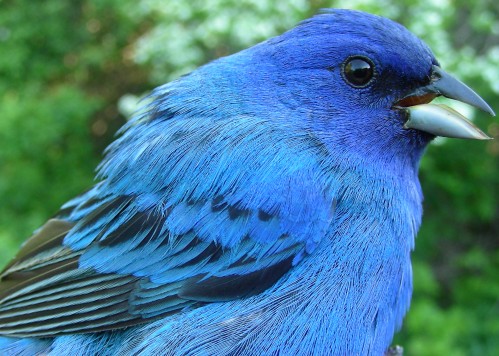
Another typical ASY male.
Photo by Marie-Anne Hudson,
McGill Bird Observatory (QC), May 2008
The distinct blue edging to the primary coverts is indicative of
after-second-year males. Note that depending on lighting, the appearance of the blue plumage may vary considerably in appearance, as shown by the photos below.
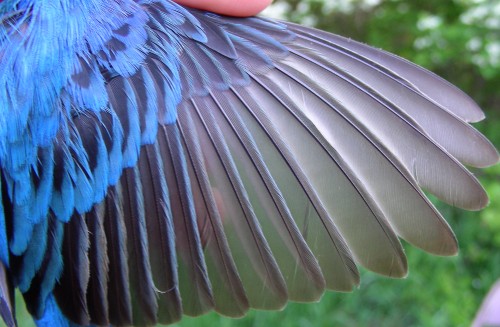
A typical ASY male wing, with bold blue edging on the greater coverts, primary coverts,
and tertials, and a bit of blue edging on some of the secondaries.
Photo by Marie-Anne Hudson,
McGill Bird Observatory (QC), May 2008

A similar example, but with narrow blue edging on all the secondaries, as well as the primaries.
Photo by Peter Pyle, Merry Lea (IN), May 2007
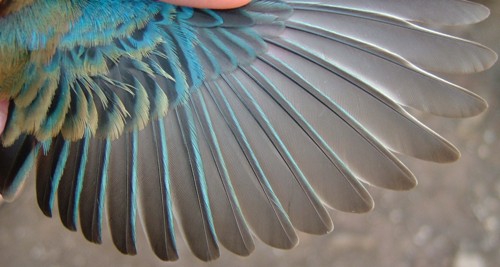
An ASY male earlier in spring, with a significant amount of buff edging to the greater coverts,
but otherwise similar to the other examples in terms of extent of blue edging on the wing.
Photo by Peter Pyle, Oaxaca (MEX), March 2010
Although both HY/SY and AHY/ASY Indigo Buntings are believed to molt their tail during winter, ASY males in spring often appear to have rectrices that are more rounded at the tip, showing less wear, and with more blue edging than SY males.
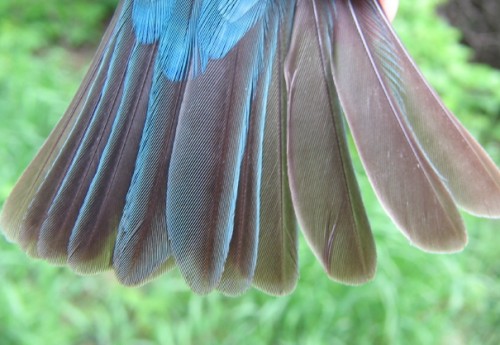
An ASY male tail in particularly good condition, showing broad and rounded rectrices with a
fair amount of blue edging, especially on the central feathers.
Photo by Marcel Gahbauer,
McGill Bird Observatory (QC), May 2006
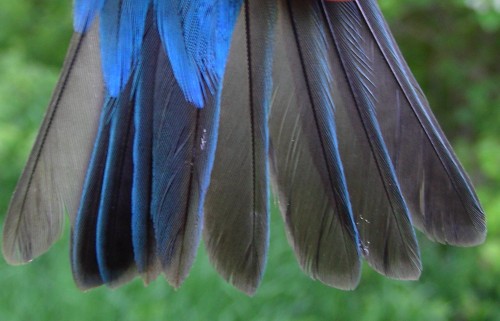
Another example of an ASY male tail with broad and fairly rounded rectrices, and somewhat
more extensive blue edging.
Photo by Marie-Anne Hudson,
McGill Bird Observatory (QC), May 2008
RETURN TO AGE/SEX
OVERVIEW
|
JAN - JUL: after-second-year
female |
After-second-year females are largely brown,
but there are often blue tinges to the plumage, especially on the lesser
coverts (shoulder) and upper tail.
Some after-second-year females show faint blue edging to the brownish
primary coverts; others such as the one below appear to lack it, but
still have some bluish tinges to the lesser and median coverts, and to a
lesser extent the greater coverts. This individual is recognizable as ASY by its broad and rounded primary coverts and the absence of any molt limits among the primaries and secondaries.

Photo by Peter Pyle,
Howell Woods (NC), May 2006
Rectrices are broad and rounded, and are brownish with a faint bluish
tinge, but the tail is of little value in ageing Indigo Buntings as
individuals of all ages are believed to replace it on their
wintering grounds.
RETURN TO AGE/SEX
OVERVIEW
|
JAN - JUL: second-year
male |
Second-year males are mostly blue, but usually enough retained brown juvenal
feathers can be spotted even on a perched bird to easily distinguish them from ASY males.
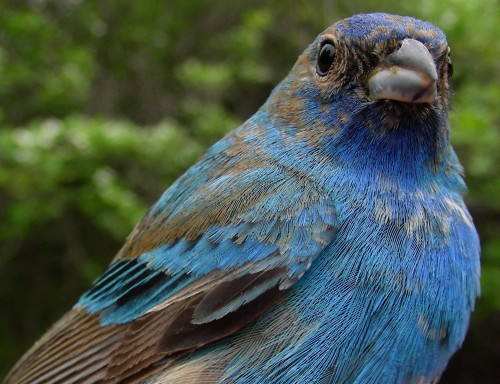
A rather mottled SY male, with flecks of brown across the head and back, in addition to a sharp
molt limit showing between the blue and black greater coverts and the brown flight
feathers.
Photo by Marie-Anne Hudson,
McGill Bird Observatory (QC), May 2009
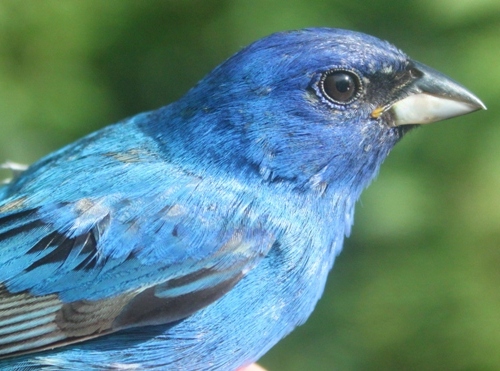
An example of a much more thoroughly blue SY male, but note that the molt limit between
brownish primary coverts without blue edging and the
adjacent greater coverts.
Photo by Peter Pyle,
Braddock Bay Bird Observatory (NY), May 2010
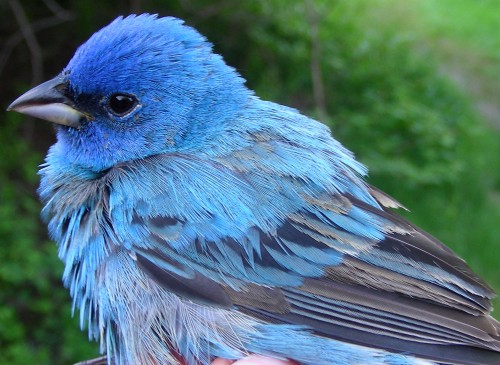
Another view of a SY male, highlighting patches of brown on the back and wings.
Photo by Marie-Anne Hudson,
McGill Bird Observatory (QC), May 2008
The opened wing provides the easiest way to recognize second-year males,
as the plain brown primary coverts always contrast noticeably with the
blue-edged greater coverts. Other common molt limits include bold contrasts among the inner secondaries and tertials and among the outermost primary coverts and alula, but as the examples below illustrate, the pattern is quite variable.
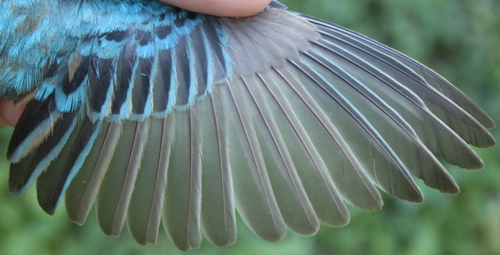
A typical SY male wing, showing a distinct molt limit between the dark greater coverts and
the retained pale juvenile primariy coverts. Note also the molt limits between the tertials
and the secondaries, and among the primaries, the result of an eccentric preformative
molt, which is quite common in this species.
Photo by Peter Pyle,
Braddock Bay Bird Observatory (NY), May 2010
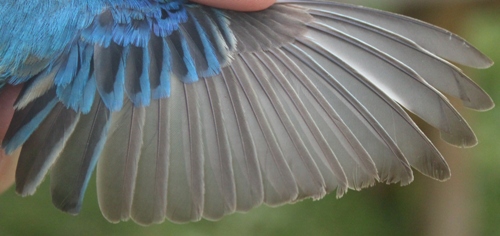
A slight variation on the pattern above, with a molt limit among the greater coverts and
another among the tertials; also note that the contrast between the retained juvenile
primaries and the outer formative primaries is less obvious than in the previous example.
Photo by Peter Pyle,
Braddock Bay Bird Observatory (NY), May 2010
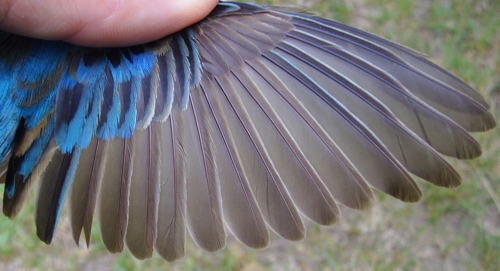
Another variation on the same theme, with a molt limit in the midst of the greater coverts,
and only the centrail tertial and the sixth secondary replaced during the prealternate molt.
Photo by Peter Pyle,
Merry Lea (IN), May 2007
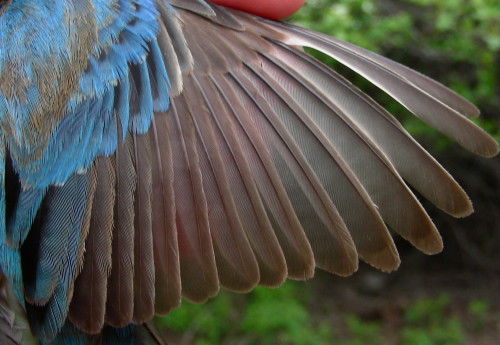
Another example where the outermost two greater coverts have not been replaced. In this
case the molt limit among the primaries is particularly indistinct.
Photo by Marie-Anne Hudson,
McGill Bird Observatory (QC), May 2009
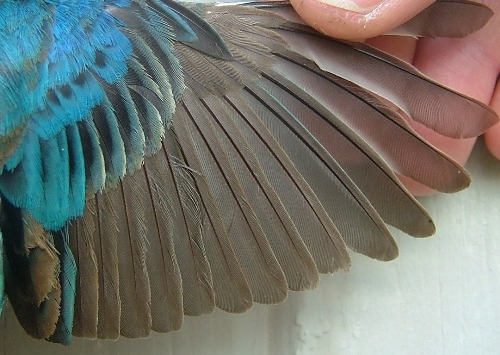
A somewhat unusual pattern, where only the first three greater coverts have been replaced
during the prealternate molt, and none of the tertials have been, yet the innermost secondary
is in alternate plumage. The eccentric molt among the primaries is quite visible in this case.
Photo by Peter Pyle,
Merry Lea (IN), May 2005
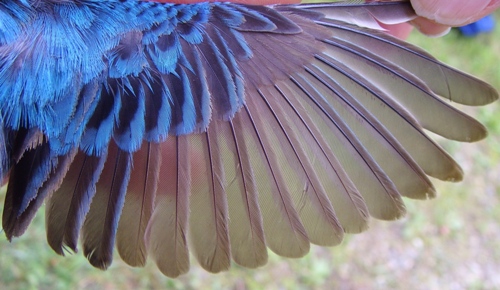
Another fairly typical pattern, except that the outermost primary covert appears to have
been replaced (black with blue edging, contrasting with the other brown juvenile coverts).
Photo by Peter Pyle,
Merry Lea (IN), May 2007
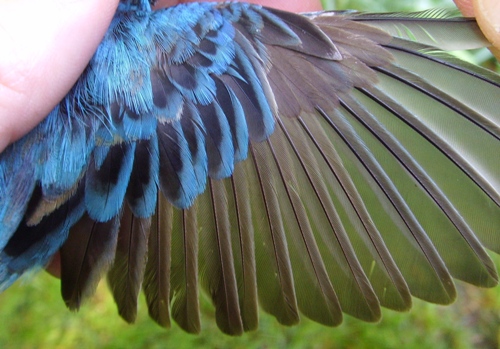
Another odd pattern among the primary coverts, with only one of the central ones
replaced, contrasting with the retained brown ones on either side.
Photo by Peter Pyle,
Merry Lea (IN), May 2007
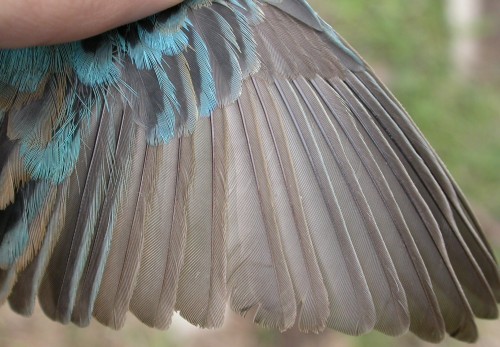
An example clearly showing the eccentric molt limits among both the primaries (only p1-2
retained) and secondaries (only s1-3 retained). It appears that the two outer primary coverts
have been replaced, but only a few greater coverts were replaced during the prealternate molt.
Photo by Marcel Gahbauer,
McGill Bird Observatory (QC), May 2005
Although both HY/SY and AHY/ASY Indigo Buntings are believed to molt their tail during winter, SY males in spring often appear to have rectrices that are somewhat more worn, tapered at the tip, and with less blue edging than ASY males.
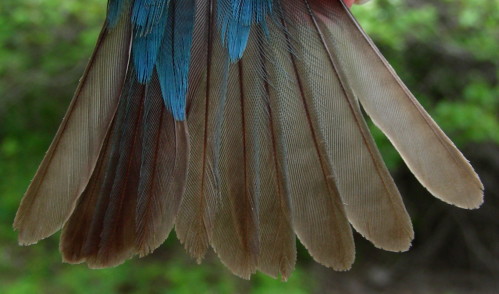
A typical SY male tail, a bit frayed at the tips, and predominantly brownish, with only a
hint of blue edging.
Photo by Marie-Anne Hudson,
McGill Bird Observatory (QC), May 2009
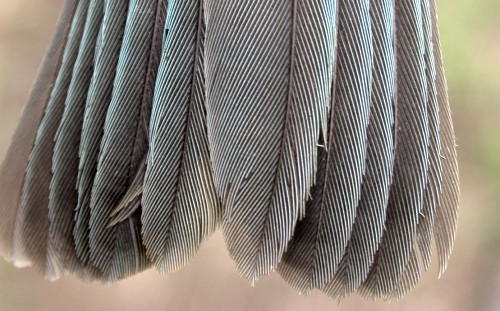
A closeup, in this case with more blue edging than the previous example, but still with
some rather pointed (relative to Indigo Buntings) feathers and apparent wear.
Photo by Marcel Gahbauer,
McGill Bird Observatory (QC), May 2005
RETURN TO AGE/SEX
OVERVIEW
|
JAN - JUL: second-year
female |
Second-year females are largely brown,
with only limited blue tinges, generally limited to the lesser coverts (shoulder). Unlike males, females are difficult to age from a perched view; a look at the open wing is generally required.
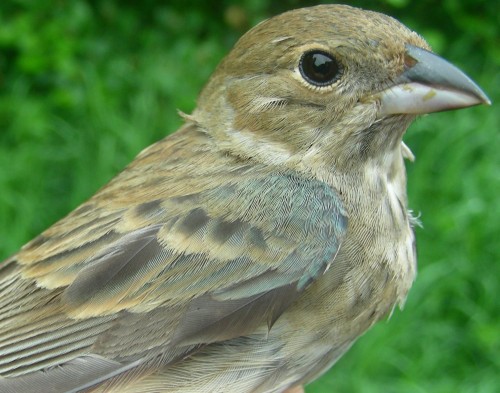
Photo by Marie-Anne Hudson,
McGill Bird Observatory (QC), May 2007
Traces of blue on the wing are largely limited to the lesser (and occasionally median) coverts. They key factor for identifying second-year females is the presence of molt limits, either among the greater coverts, between the greater coverts and primary coverts, or among the primaries and/or secondaries.

In this example, the molt limit is most apparent among the primaries, with the inner three
being retained juvenile feathers, and the outer ones replaced during an eccentric
preformative molt. In this case there is also one aberrantly replaced secondary (s4).
Photo by Peter Pyle, Braddock Bay Bird Observatory (NY), May 2010
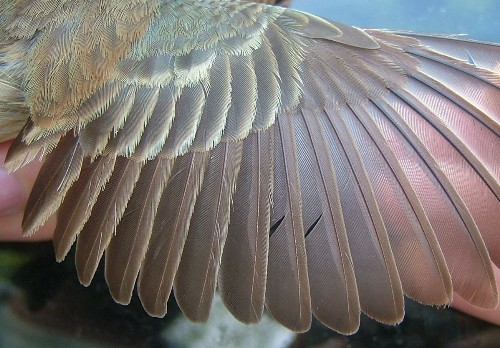
Few if any feathers appear to have been replaced during the prealternate molt. There is a
subtle molt limit between the formative greater coverts and the juvenile primary coverts;
again a better contrast is visible among the primaries, in this case the inner four being
brown retained juvenile feathers, and the outer five being formative feathers (the contrast
is most evident my comparing the brown vs. black feather shafts).
Photo by Peter Pyle,
Merry Lea (IN), May 2005
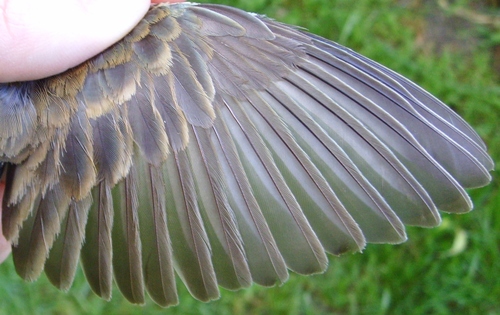
Another example showing a minimal prealternate molt (it appears to be more limited on
SY females than SY males), with a molt limit again among the primaries.
Photo by Peter Pyle,
Merry Lea (IN), May 2007
Although SY female tails tend to average somewhat more worn than ASY female tails, differences in colour are much more subtle than on males, and in general the tail is of little help in determining age in spring.
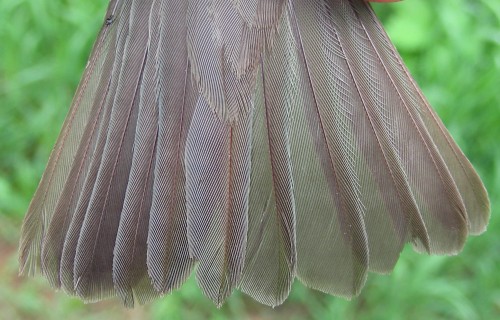
Photo by Marie-Anne Hudson,
McGill Bird Observatory (QC), May 2007
RETURN TO AGE/SEX
OVERVIEW
|
JUL - DEC: after-hatch-year
male |
After-hatch-year
males in fall have a variably mottled blue/brown appearance, usually
retaining at least some blue feathers on the breast and especially on
the lesser coverts.
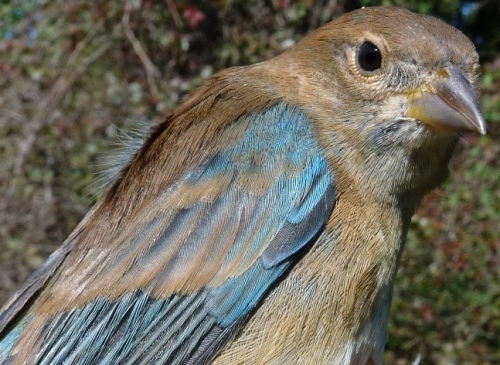
A relatively typical fall AHY male, with a few flecks of blue remaining among the body
feathers, and distinctly blue and black wings.
Photo by Marcel Gahbauer, McGill Bird Observatory (QC), September 2009
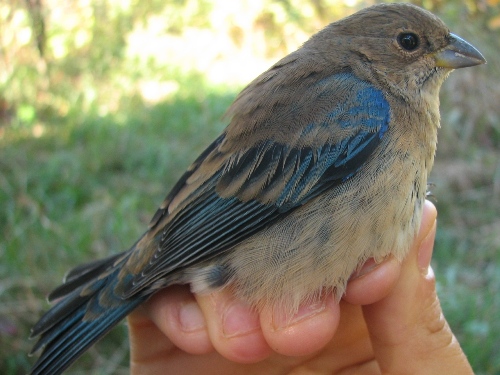
Another typical AHY male, in this case illustrating the blue on the tail as well.
Photo by Barbara Frei,
McGill Bird Observatory (QC), September 2007

Early in fall it is possible to see some ASY males that still are entirely blue.
Photo by Marcel Gahbauer, McGill Bird Observatory (QC), August 2009
After-hatch-year males can be recognized
simply by overall body plumage if there is a substantial amount of blue present (especially if there is any on the breast). A view of the open wing may permit the age to be further refined to second-year or (occasionally) after-second-year. Individuals showing distinct blue edging to the primary coverts are likely to be after-second-year, especially if seen during migration, as these feathers are replaced only during the first prebasic molt, which most second-year birds are unlikely to complete until on wintering grounds.
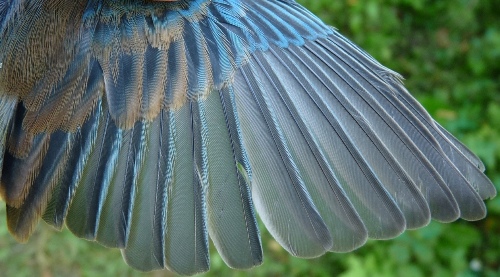
An AHY male during the late stages of prebasic molt, replacing the inner secondaries. The
wing is generally dark, with blue edging to most feathers.
Photo by Marcel Gahbauer, McGill Bird Observatory (QC), September 2009
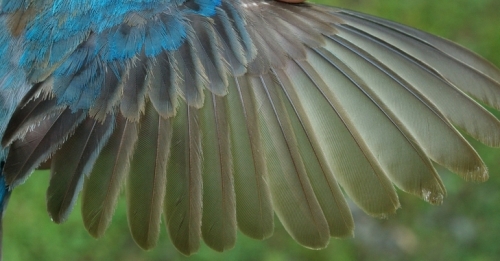
This is a typical SY male pattern, from a bird caught in early fall prior to its prebasic molt.
Photo by Simon Duval, McGill Bird Observatory (QC), August 2010
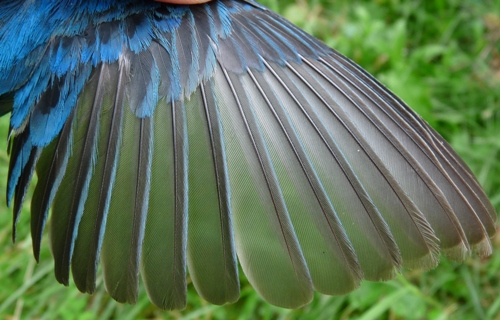
This is a typical ASY male pattern, although showing a bit of wear due to the date, from
a bird caught in early fall prior to its prebasic molt.
Photo by Marcel Gahbauer, McGill Bird Observatory (QC), August 2009
The tail of AHY Indigo Buntings is broad and rounded, contrasting with the narrow and tapered juvenal rectrices of HY individuals. Males show considerable blue edging on the tail, especially the central rectrices.
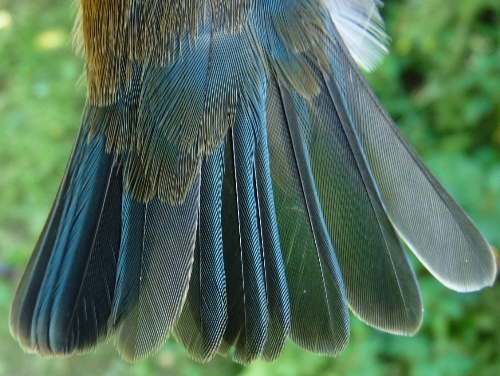
A good example of the broad and rounded shape of AHY Indigo Bunting rectrices, and
the extent of blue edging often present on the tail of AHY males.
Photo by Marcel Gahbauer, McGill Bird Observatory (QC), September 2009
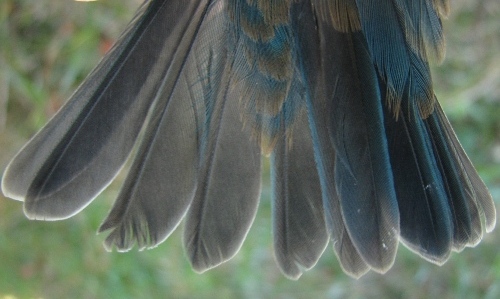
A similar example, but with the blue edging somewhat less extensive.
Photo by Barbara Frei,
McGill Bird Observatory (QC), September 2007
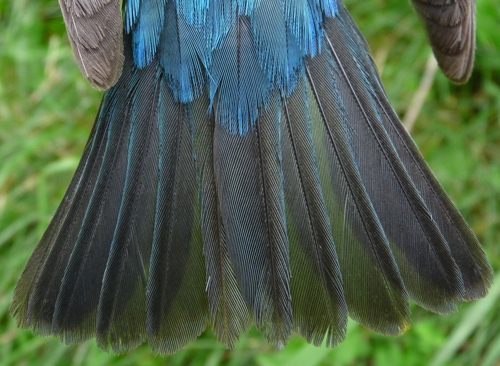
Similar to the first couple of examples but showing more wear; this photo matches the ASY
individual shown above that was caught before its prebasic molt.
Photo by Marcel Gahbauer, McGill Bird Observatory (QC), August 2009
RETURN TO AGE/SEX
OVERVIEW
|
JUL - DEC: after-hatch-year
female |
After-hatch-year
females in fall are largely brown, but may have tinges of blue on the wing and/or tail. The overall plumage is quite similar to that of hatch-year birds, and age should be determined through close examination of the open wing and/or viewing of skull pneumaticization (until mid-October).
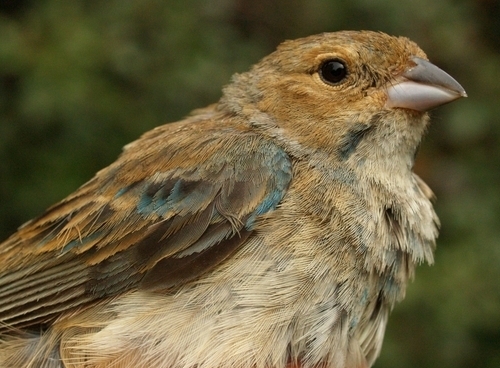
This female was photographed prior to beginning its prebasic molt; note the worn condition
of the feathers, as well as the presence of some blue in the median and greater coverts
(which would not be expected on HY birds at this date).
Photo by Simon Duval, McGill Bird Observatory (QC), August 2010
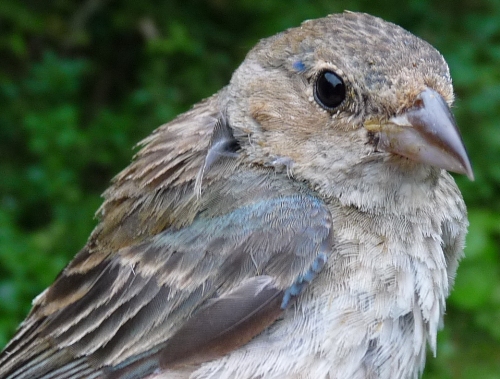
A somewhat paler AHY female, also photographed prior to the start of its prebasic
molt, judging by the frayed feathers on the wing, back, and breast.
Photo by Marcel Gahbauer, McGill Bird Observatory (QC), September 2009
The wing of an after-hatch-year female features fairly broad and rounded primary coverts and a lack of molt limits.
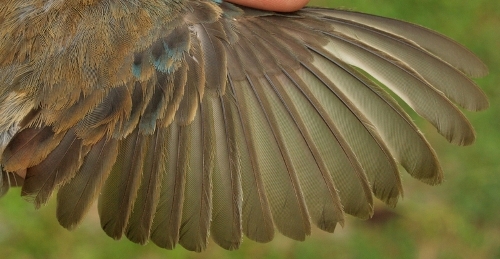
This wing is rather worn, more so than a HY would be at this age. This might be a SY female,
as it looks like there might be eccentric molt limits between p3-p4 and s2-s3, but they are
subtle and by this point the age is best assessed as AHY.
Photo by Simon Duval, McGill Bird Observatory (QC), August 2010
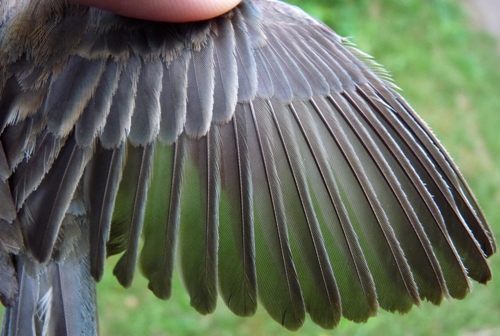
A wing very uniform in appearance, also showing wear as this bird has not yet begun its
prebasic molt. Given the lack of any visible molt limits, this is likely an ASY female, but given
that molt limits on females can be indistinct by this time, AHY is again a better choice.
Photo by Marcel Gahbauer, McGill Bird Observatory (QC), September 2009
The rectrices of AHY Indigo Buntings are generally broad and rounded.
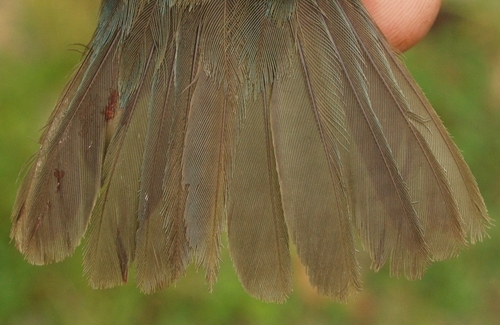
This tail corresponds to the first bird in the previous sections; the more extreme amount of
wear on the rectrices (especially the central pair) also supports the thought that this
might be a SY female.
Photo by Simon Duval, McGill Bird Observatory (QC), August 2010
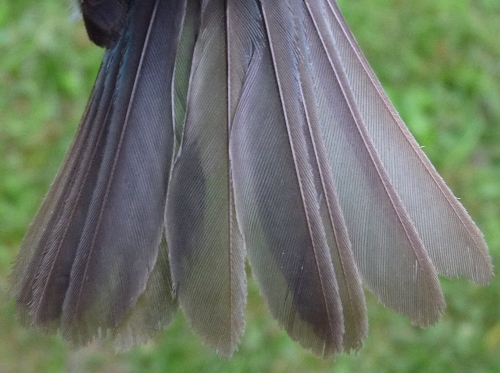
This tail corresponds to the second bird in the previous sections; the lesser amount of
wear on the rectrices also supports the thought that it might be an ASY female.
Photo by Marcel Gahbauer, McGill Bird Observatory (QC), September 2009
RETURN TO AGE/SEX
OVERVIEW
|
JUL - DEC: second-year
male |
Second-year males are a
subclass of after-hatch-year males, highly variable in appearance but readily recognizable until they have
completed their first prebasic moult (during their second fall or winter). Early in fall they may still appear largely blue, while later they feature a very scruffy mottled blue and brown plumage, and eventually as the prebasic molt progresses they become largely brown with some traces of blue remaining on the wings, tail, and upper breast, at which point SY and ASY are generally indistinguishable (refer to the AHY section above).
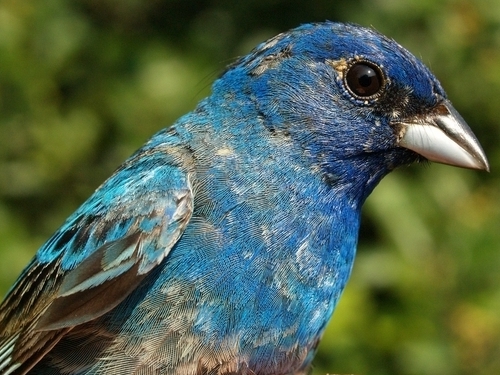
An SY male caught during the early stages of its prebasic molt, still with mostly blue
body feathers; the brown and very worn primary coverts are a good indicator of age.
Photo by Simon Duval, McGill Bird Observatory (QC), August 2010
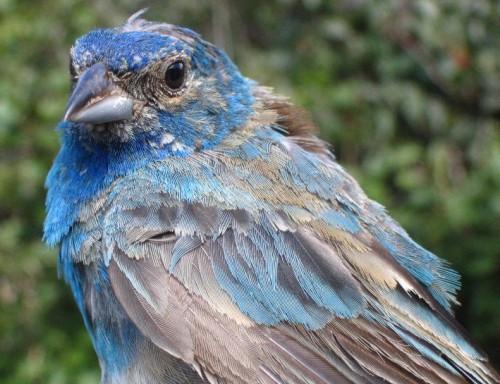
A somewhat paler example, showing even more feather wear.
Photo by Seabrooke Leckie,
McGill Bird Observatory (QC), August 2006
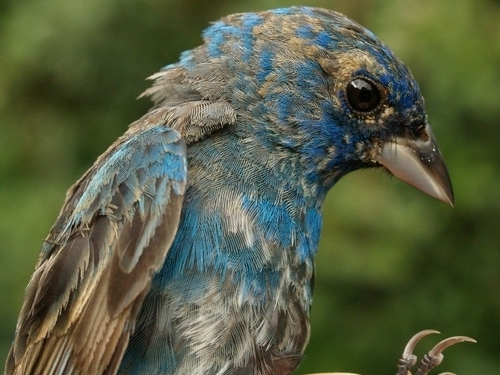
Another example, with even less blue and paler brown on the wing.
Photo by Simon Duval,
McGill Bird Observatory (QC), August 2010
The distinct molt limit between plain brown primary coverts and blue-edged greater coverts is indicative of a second-year male Indigo Bunting. Usually there is also a distinct contrast between the retained juvenile secondaries and adjacent feathers (tertials and greater coverts).
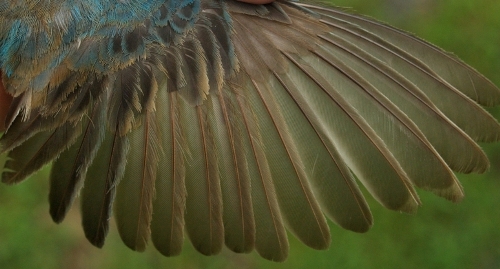
An SY male that had a relatively limited prealternate molt in spring, therefore the molt limit
between the formative greater coverts and juvenile primary coverts is relatively subtle since
all feathers are somewhat old and worn by this time. However, notice the eccentric molt limit
among the primaries from the preformative molt, as well as the contrast among the secondaries.
Photo by Simon Duval,
McGill Bird Observatory (QC), August 2010
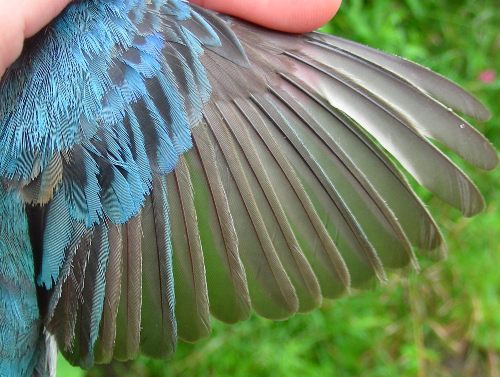
A rather different looking SY male wing, since this individual had a much more extensive
prealternate molt, which accentuates the contrast between the greater coverts and primary
coverts. Again though, molt limits are also visible among the primaries and secondaries.
Photo by Marie-Anne Hudson, McGill Bird Observatory (QC), August 2008
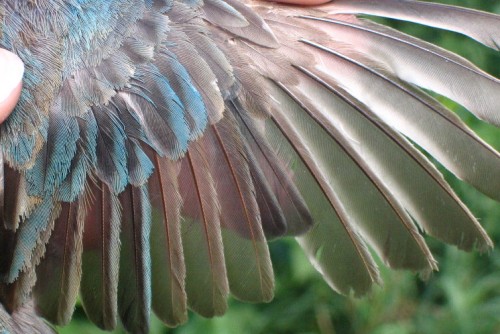
An SY male beginning to replace its primaries; note the strong contrast between the new
basic feathers and the adjacent brown juvenile secondaries.
Photo by Seabrooke Leckie,
McGill Bird Observatory (QC), August 2006
The tail of a second-year Indigo Bunting in fall
usually is fairly broad and rounded as is the norm for this species in general, but typically also shows a fair amount of wear.
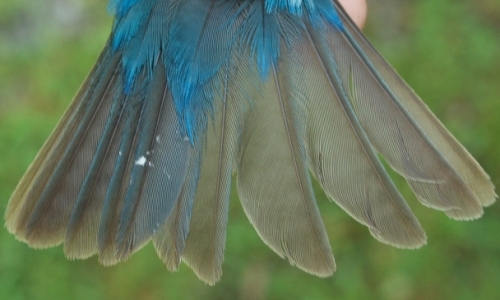
A fairly typical SY tail, a bit faded and tattered at the tips, and perhaps not quite as broad
as would be expected on ASY birds.
Photo by Simon Duval, McGill Bird Observatory (QC), August 2010
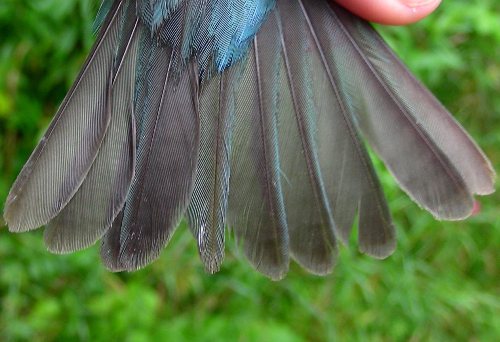
A particularly dark SY male tail with a lot of blue edging, corresponding to the wing in
the preceding section with a particularly extensive prealternate molt.
Photo by Marie-Anne Hudson, McGill Bird Observatory (QC), August 2008
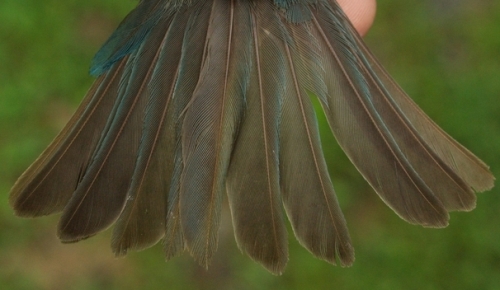
A paler SY tail, with somewhat narrower and browner rectrices.
Photo by Simon Duval,
McGill Bird Observatory (QC), August 2010
RETURN TO AGE/SEX
OVERVIEW
|
JUL - DEC: second-year
female |
Second-year females are a
subclass of after-hatch-year females, sometimes recognizable until they have completed their first prebasic molt (during their second fall or winter). The best clues are distinct molt limits on the wings, but overall appearance may also be helpful.
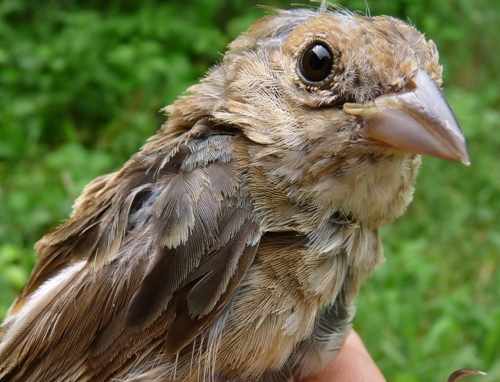
This is clearly an AHY female by virtue of its worn plumage and overall brown appearance
in August; the particularly worn primary coverts visible from this angle are suggestive of
it being SY, but not conclusive.
Photo by Marcel Gahbauer,
McGill Bird Observatory (QC), August 2009
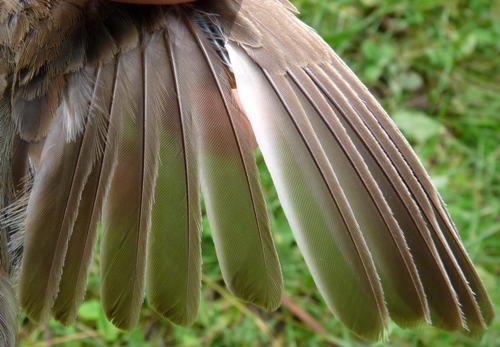
This photo shows the new primaries just beginning to grow in. The wear on the old primary
coverts,
primaries, and secondaries is considerable, again suggestive of them being
juvenile feathers, but the lack of any distinct molt limit means it should probably be
considered
AHY based on the wing alone.
Photo by Marcel Gahbauer,
McGill Bird Observatory (QC), August 2009
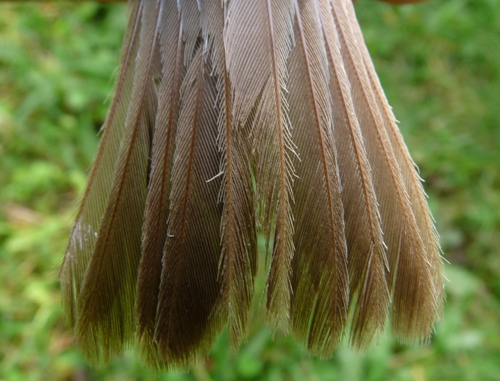
Indigo Buntings generally have rather broad and rounded tails that become only
moderately worn; the extreme amount of wear on this tail strongly suggests that
it is a SY female rather than ASY.
Photo by Marcel Gahbauer,
McGill Bird Observatory (QC), August 2009
RETURN TO AGE/SEX
OVERVIEW
|
JUL - DEC: hatch-year
male |
Sex of hatch-year
Indigo Buntings cannot always be determined, but if there are
blue-tinged feathers scattered across the breast and extensively on the
wing as in the birds below, they can be reliably called males. Note that appearance can vary over the course of time, as eccentric molt of the primaries and secondaries may begin by middle of fall.
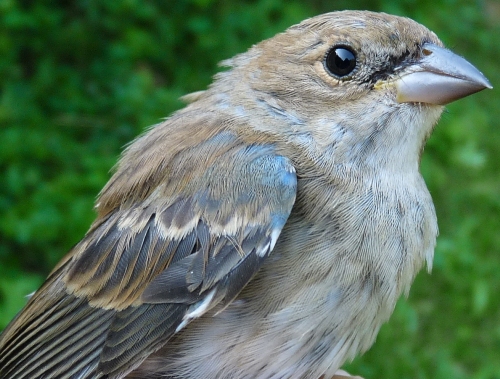
A typical HY male, with blue mostly limited to the lesser coverts.
Photo by Marcel Gahbauer, McGill Bird Observatory (QC), September 2009
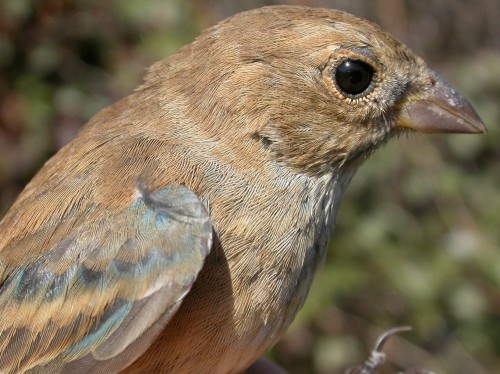
A slight variant, with blue also in the median coverts, and on one greater covert.
Photo by Marcel Gahbauer,
McGill Bird Observatory (QC), August 2005
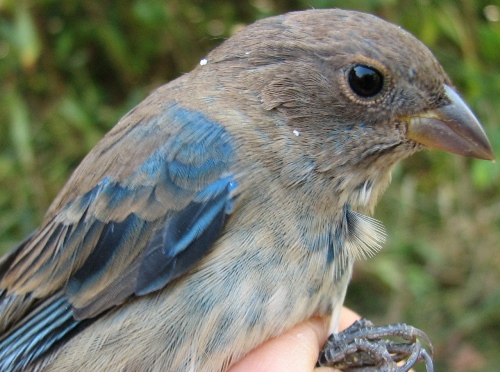
A photo taken later in fall, after the preformative molt has begun, showing more blue on
the wing and back, and a bit on the breast too.
Photo by Barbara Frei, McGill Bird Observatory (QC), October 2008
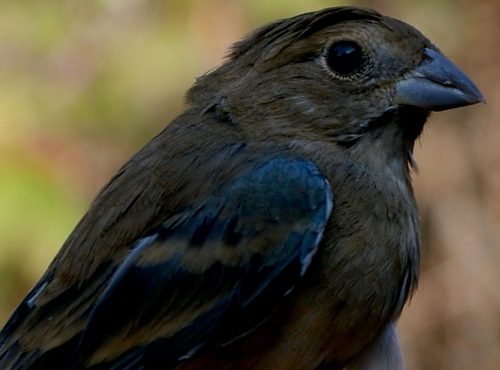
Another HY male from late fall with the preformative molt largely completed.
Photo by James Junda, McGill Bird Observatory (QC), October 2008
The extent of blue on the wing can be quite variable. On some individuals it is initially limited to the lesser coverts, while others also have some blue in the median or even greater coverts. Later in fall, once the preformative molt has begun, the outer primaries, inner secondaries, and more of the greater coverts also acquire blue edging.
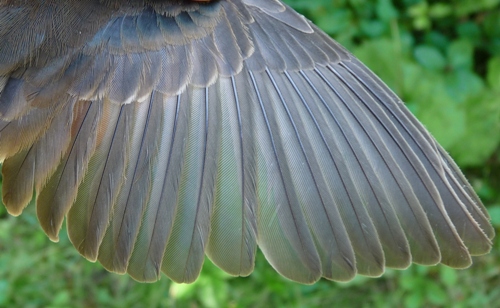
An intermediate example, with a fair amount of blue in the median coverts.
Photo by Marcel Gahbauer, McGill Bird Observatory (QC), September 2009
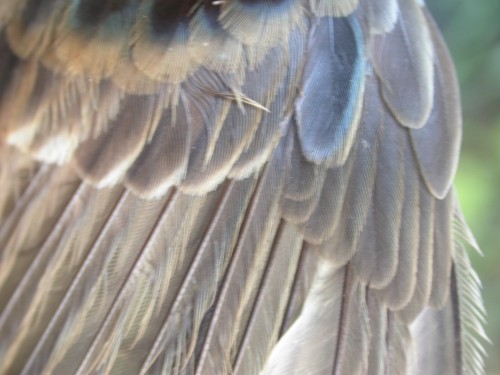
An unusual case with the carpal covert already showing blue edging in August.
Photo by Marcel Gahbauer,
McGill Bird Observatory (QC), August 2005
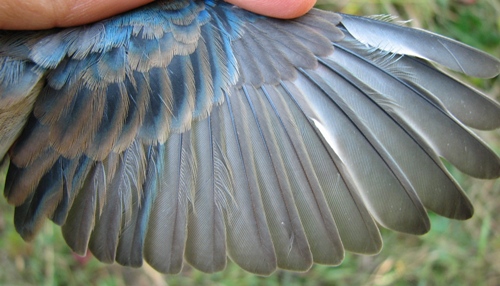
A HY male later in fall, having already replaced the outer five primaries, s3, and all the
greater and median coverts, and currently replacing s6.
Photo by Barbara Frei, McGill Bird Observatory (QC), October 2008
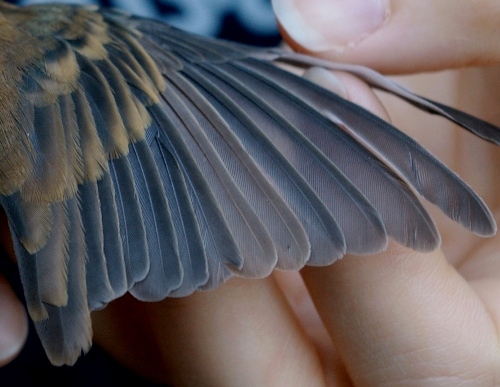
A HY male after an unusually extensive preformative molt, having replaced all secondaries
and all but the two innermost primaries and primary coverts, yet with very little blue compared
to the previous example (this wing corresponds to the last bird in the previous section).
Photo by James Junda,
McGill Bird Observatory (QC), September 2008
The relatively narrow and pointed
rectrices of HY Indigo Buntings are one of the easiest ways to separate
them from older birds, at least prior to the preformative molt. Males usually have some blue edging, though it can be minimal (e.g. second photo, which is of the same bird with the blue carpal covert above).
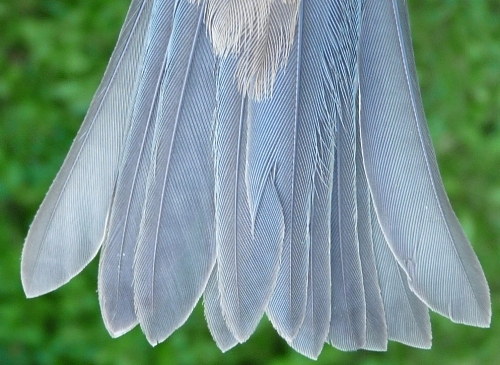
A typical HY male tail, with somewhat tapered rectrices and a bit of blue edging.
Photo by Marcel Gahbauer, McGill Bird Observatory (QC), September 2009
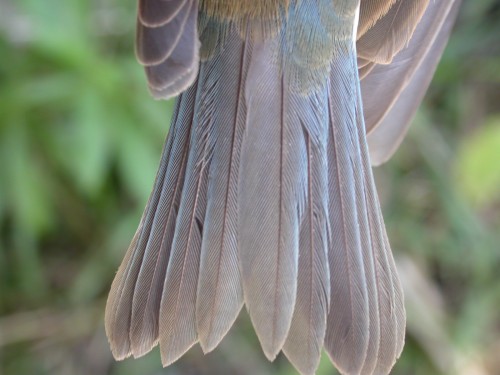
An example of narrower and more distinctly pointed rectrices; note the blue rump.
Photo by Marcel Gahbauer,
McGill Bird Observatory (QC), August 2005
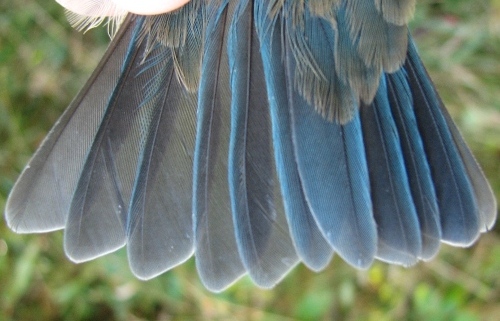
Fresh and much broader and rounder rectrices following the preformative molt; this is
usually only seen late in fall.
Photo by Barbara Frei, McGill Bird Observatory (QC), October 2008
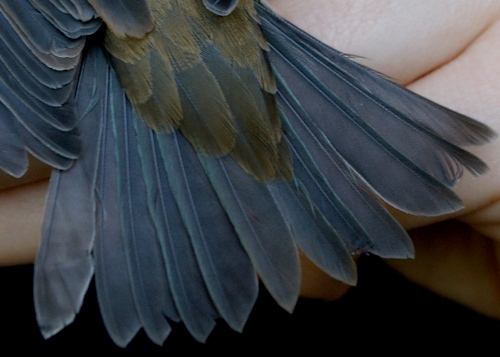
Another late fall HY male following the preformative molt, but without blue in the rump, and
with rectrices that have either not been replaced, or are relatively narrow and pointed
despite having been replaced.
Photo by James Junda,
McGill Bird Observatory (QC), September 2008
RETURN TO AGE/SEX
OVERVIEW
|
JUL - DEC: hatch-year
unknown (probable female) |
Hatch-year
females are generally brown all over, lacking blue; some males may also
be lacking blue prior to their first prebasic moult, so birds with such
an appearance are generally considered sex unknown.

A typical HY female/unknown Indigo Bunting, with barely any blue plumage.
Photo by Barbara Frei,
McGill Bird Observatory (QC), September 2007
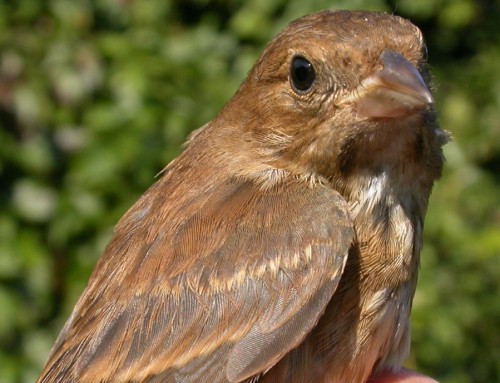
Another HY female/unknown, a bit richer brown in colour, with no blue plumage at all.
Photo by Marcel Gahbauer,
McGill Bird Observatory (QC), August 2005
Note the complete absence of blue anywhere on the
wing.
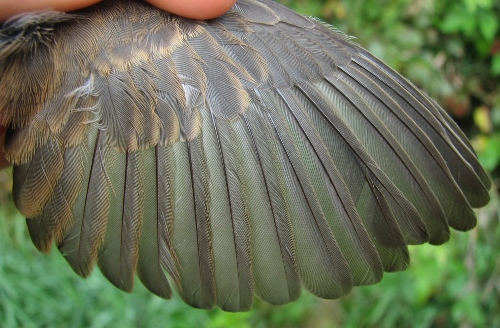
Photo by Barbara Frei,
McGill Bird Observatory (QC), September 2007
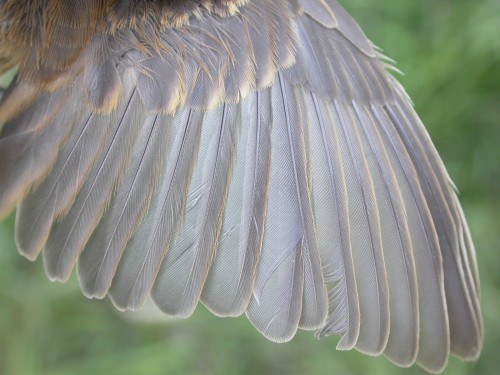
Photo by Marcel Gahbauer, McGill Bird Observatory (QC), August 2005
The rectrices are
relatively narrow and pointed, contrasting with the broader and more
rounded rectrices on after-hatch-year buntings. On females they generally lack blue edging.
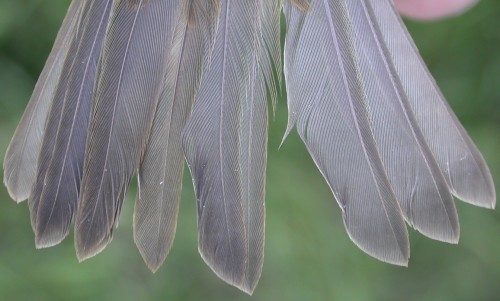
Photo by Marcel Gahbauer,
McGill Bird Observatory (QC), August 2005
RETURN TO AGE/SEX
OVERVIEW
JUL - SEP: juvenile
unknown |
Juveniles can be recognized by their loose body plumage and distinctly broad gape; they are generally brown, without any blue, and sex cannot be determined.
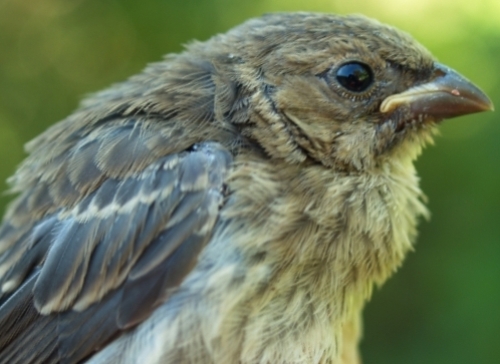
Photo by Simon Duval,
McGill Bird Observatory (QC), September 2009
Note the complete absence of blue anywhere on the
wing.
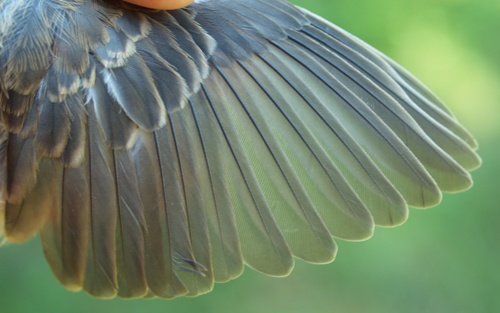
Photo by Simon Duval,
McGill Bird Observatory (QC), September 2009
The rectrices of juveniles may just be growing in, as is the case in this photo. They would be expected to be somewhat narrow and pointed, as usually seen on HY birds, but this example shows them to be relatively broad and rounded.
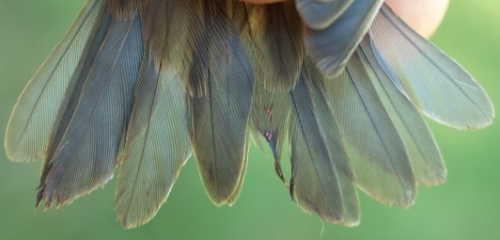
Photo by Simon Duval,
McGill Bird Observatory (QC), September 2009
RETURN TO AGE/SEX
OVERVIEW








































































































